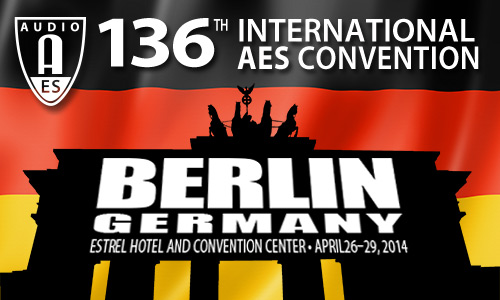
AES Berlin 2014
Paper Session P6
P6 - Room Acoustics
Sunday, April 27, 16:30 — 18:30 (Room Paris)
Chair:
Ben Kok, BEN KOK - acoustic consulting - Uden, The Netherlands
P6-1 Infrasound in Vehicles—Theory, Measurement, and Analysis—John Vanderkooy, University of Waterloo - Waterloo, ON, Canada
Infrasound (IS) in cars is quite strong and may be responsible for health effects. This paper presents measurements and simplified mechanisms for the production of IS in vehicles. Four mechanisms are proposed: (1) turbulence from the moving vehicle or other traffic, infusing through the vents; (2) flexing of the body causing volume changes; (3) acceleration of the vehicle, causing an inertial reaction from the enclosed and external air; and (4) pressure variations due to altitude changes. The acoustic pressure from these mechanisms can be simplified by the fact that IS wavelengths are much larger than the size of the vehicle. Measurements are interesting and analyzed to elucidate the acoustic contribution of each mechanism.
Convention Paper 9049 (Purchase now)
P6-2 Open Plan Office Acoustics and Computer Modeling: Theory versus Practice—Lise W. Tjellesen, Applied Acoustic Design (AAD) - Ataines, UK
The acoustics of open plan offices and offices in general has long been the subject of numerous studies looking at privacy levels and speech intelligibility. As acoustic consultants, office design is often dealt with on a daily basis, and various guidance’s such as national / international standards, building regulations or general codes of practice are normally used as references when carrying out the design. In more complex designs of offices, especially open plan offices, computer modeling is used more and more as an integral and important tool alongside accumulated experiences from measurements. This paper explores the problems and challenges of using computer modeling in connection with open plan office design.
Convention Paper 9050 (Purchase now)
P6-3 On Low and Mid Frequencies Sound Absorption Characteristics of Porous Materials—Elena Prokofieva, Edinburgh Napier University - Edinburgh, UK
Porous materials are frequently used in sound insulation applications. In building acoustics they are installed inside the separating constructions to absorb unwanted mid and high frequencies propagating through them. Although it is not required by UK Building Regulations, low frequency noise transferred through separating partitions is considered as a nuisance by occupants and could and should be addressed. A laboratory study had been conducted to investigate the effect of various types of porous materials that may be used for partition fillings on the sound absorption over low and mid frequencies. The results suggest that open pore materials could improve low frequency range of absorption while have no detrimental effect on mid frequency absorption level.
Convention Paper 9051 (Purchase now)
P6-4 Optimizing Microphone Placement and Formats for Assistive Listening System Sound Pick-Up—Peter Mapp, Peter Mapp Associates - Colchester, Essex, UK
Approximately 10 – 14% of the general population (USA & Northern Europe) suffer from a noticeable degree of hearing loss and would benefit from some form of hearing assistance or deaf aid. However, many assistive listening systems do not provide the benefit that they should, as they are often let down by their poor acoustic performance. The paper investigates the acoustic and speech intelligibility requirements for ALS performance and examines a number of microphone pick-up scenarios in terms of their potential intelligibility and sound quality performance. The results of testing carried out in a number of rooms and venues are presented, mainly in terms of the resultant Speech Transmission Index (STI) measurements. The paper concludes by providing a number of recommendations and “rules of thumb” for successful microphone placement and testing.
Convention Paper 9052 (Purchase now)
